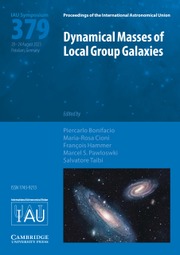No CrossRef data available.
Article contents
The oblateness of dark matter halos of nearby galaxies and its correlation with gas mass fractions
Published online by Cambridge University Press: 30 October 2025
Abstract
We present a method to measure the the oblateness parameter q of the dark matter halo of gas rich galaxies that have extended HI disks. We have applied our model to a sample of 20 nearby galaxies that are gas rich and close to face-on, of which 6 are large disk galaxies, 8 have moderate stellar masses and 6 are low surface brightness (LSB) dwarf galaxies. We have used the stacked HI velocity dispersion and HI surface densities to derive q in the outer disk regions. Our most important result is that gas dominated galaxies (such as LSB dwarfs) that have M(gas)/M(baryons)>0.5 have oblate halos (q<55), whereas stellar dominated galaxies have a range of q values from 0.2 to 1.3. We also find a significant positive correlation between q and stellar mass, which indicates that galaxies with massive stellar disks have a higher probability of having halos that are spherical or slightly prolate, whereas low mass galaxies preferably have oblate halos. We briefly also discuss how the halo shape affects the disks of galaxies, especially the oblate halos.
Information
- Type
- Contributed Paper
- Information
- Proceedings of the International Astronomical Union , Volume 19 , Symposium S379: Dynamical Masses of Local Group Galaxies , December 2023 , pp. 353 - 359
- Copyright
- © The Author(s), 2025. Published by Cambridge University Press on behalf of International Astronomical Union


